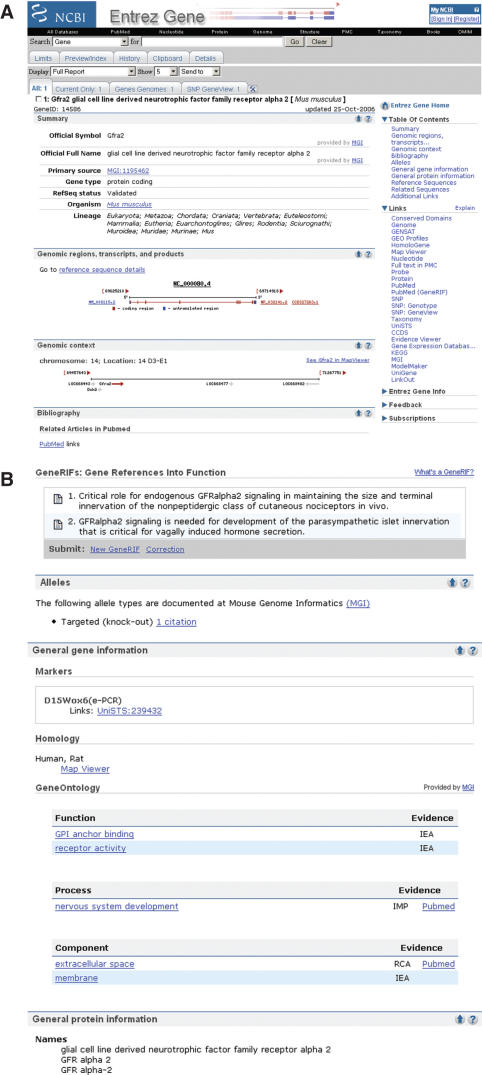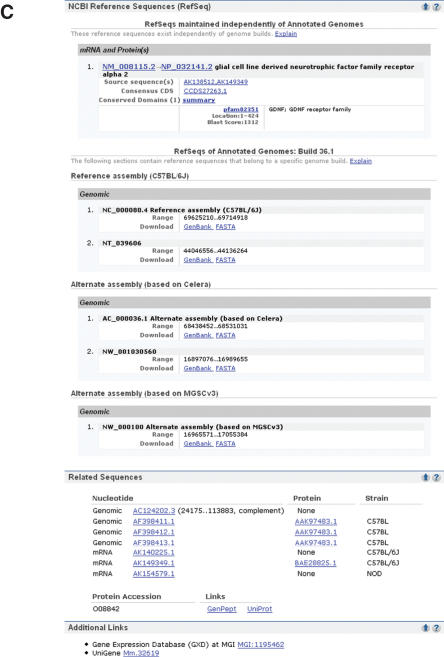Figure 2.
(a) Representative Entrez gene full-report page, part 1. The full-report display. The standard gene-specific report page starts with summary information about the gene, a table of contents and a links menu. The summary section includes names and symbol aliases. If the gene has official names provided by a nomenclature authority, those names are reported as official symbol and official full name, with the named source anchoring a link. The database identifier provided by that source is displayed, anchoring a link to that source's specific record. The review status of all RefSeq RNAs for the gene is reported as RefSeq status. If the gene has been annotated on a RefSeq genomic sequence, a graphic is provided diagramming the intron/exon organization of the gene (genomic regions, transcripts and products) with the accessions for the genomic, mRNA and protein RefSeqs anchoring links to the sequence records in NCBI's Entrez system and, in the case of proteins, to BLink (1). If a RefSeq protein is a member of a CCDS group (2), the CCDS identifier to the right of the RefSeq protein accession anchors a link to the CCDS database. The genomic context section diagrams the placement of the gene and its neighbors. Each symbol anchors a link to another record in Entrez Gene. A link to NCBI's map viewer is in this section, identical to the one in the links menu. All citations in PubMed associated with a record in gene can be accessed by clicking on PubMed in the bibliography section or in the links menu. Navigation to PubMed for citations associated with specific information, such as GeneRIFs or gene ontology terms, is repeated explicitly with those elements (b). The links menu should be used to determine the types and sources of additional information that may be available about a gene. In this example, information about expression is available from GENSAT, GEO, UniGene and MGI; homology from HomoloGene, variation from SNP; cDNAs supporting genomic annotation from evidence viewer and ModelMaker, pathways from KEGG, etc. (b) Representative Entrez gene full report page, part 2. This portion of a full report display includes the sections of the record indicated in the table of contents (a) as bibliography, alleles, general gene information and general protein information. In the GeneRIFs section, the icons to the right of the text anchor a link to the PubMed that supports the GeneRIF. The data in the alleles and gene ontology sections were imported from MGI, as indicated in the links anchored by MGI. Alternate names for the gene, and the protein it encodes, are listed under general protein information/names. If this gene encoded an enzyme, the E.C. designation would be in this section as well. (c) Representative Entrez gene full report page, part 3. This portion of a full report display includes the sections of the record indicated in the table of contents (a) as reference sequences, related sequences and additional links. The reference sequences section is subdivided into subsections based on the type of RefSeq being reported. The first section (RefSeqs maintained independently of annotated genomes) reports the RefSeq genomic, RNA and protein accessions that can be updated at any time, and thus may differ in version or number from what was included in a genomic annotation (2). The sequences reported under RefSeqs of annotated genomes are the genomic RefSeqs for the chromosomes and contigs of reference and alternate assemblies. Each of these RefSeq sections, and the related sequences sections below, anchors links to records in NCBI's Entrez system, where standard tools are provided to process the sequence (e.g. altering the range, displaying annotated SNPs or downloading in multiple formats). The related sequences section lists the accessions and strains of public sequences of this gene or its encoded protein. The items in the additional links section are included in the Links menu (a), but are selected to be repeated here to enhance access, for example to display UniGene cluster number.


